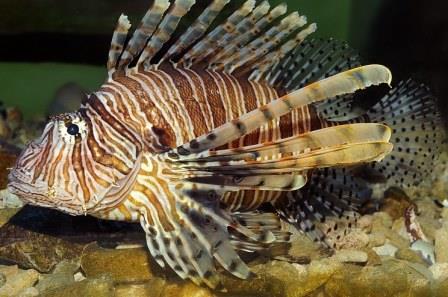When organisms establish new, enduring populations in locations outside their native ranges, they are called invasive species. Because invasive species can significantly disrupt the sensitive interactions within the ecology of preexisting communities, they can pose a serious threat to the integrity and maintenance of ecosystems. See also: Biodiversity; Ecological communities; Ecology; Ecosystem; Invasive species and their effects on native species
One such instance of an invasive species having dramatic and drastic consequences in the marine realm concerns the red lionfish (Pterois volitans). This beautifully colored, venomous fish is indigenous to the reefs and corals of the western Pacific Ocean, ranging from Japan to Australia. Yet, since the early 2000s, this fish has also become firmly established along the United States coastlines of the Atlantic Ocean and the Gulf of Mexico (from Florida to Connecticut, although mostly from North Carolina southwards to the Florida Keys) and the Caribbean coasts of Central America and South America. See also: Biogeography; Invasion ecology; Population ecology; Scorpaeniformes

Thoughtless human intervention is the likely cause of the lionfish's entry into the Atlantic Ocean. Lionfish are popular home aquarium fish. In the 1980s, it was noted that some aquariumists intentionally released these pet fish into the waters along the U.S. southeastern Atlantic coastline, which could have set the stage for lionfish to begin their invasive dominance. Another, less probable possibility involves the ballast water of commercial ships. In the past, numerous marine species (for example, zebra mussels) have been transferred to new locales via the ballast water of large ocean-going vessels. See also: Ecological succession; Marine transportation and the environment
Because lionfish are not endemic inhabitants of the Atlantic Ocean and the Gulf of Mexico, they have very few natural predators in these regions and can thrive, outcompeting other fish species for food resources. In doing so, they have disrupted the ecological dynamics and food-web health of the local coral-reef communities. See also: Ecological competition; Food web
Camouflage and speed are the main weapons that lionfish use to capture prey. (Lionfish are also armed with venom, which they can deliver through numerous needle-like defensive spines, but it does not play a role in the fish's predatory capabilities.) In particular, lionfish devour juvenile grunts, snapper, and grouper, as well as small crustaceans such as shrimp. Investigations have shown that lionfish are rapidly depleting the stock of native fishes. For example, more than 1000 lionfish per acre have been found in some areas, far surpassing the densities of the local reef fish species. Indeed, since the lionfish's introduction, the populations of local reef fish have declined by 80%. Thus, the reef communities are being altered and many native species are facing extinction. See also: Coral reef complexity; Endangered species; Extinction (biology); Population viability; Predator-prey interactions; Reef
Unfortunately, there is no pat solution to combat this problem. Large-scale control measures and management strategies to eradicate the lionfish are generally considered to be impractical and too costly. In general, firmly established invasive species in marine environments are impossible to remove and eliminate. Some concerned parties are encouraging more human consumption of lionfish in hopes that a market for them will help to reduce their numbers, but the effectiveness of this strategy is still unproved.





